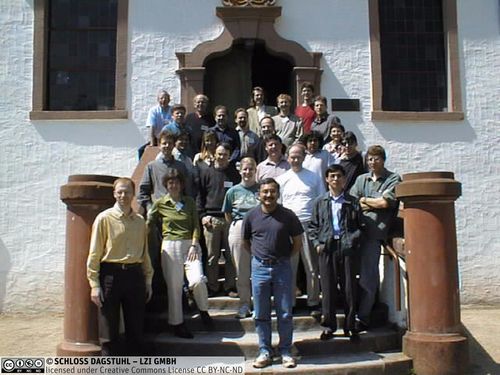Dagstuhl-Seminar 01191
Computational Cartography and Spatial Modelling
( 06. May – 11. May, 2001 )
Permalink
Organisatoren
- Marc van Kreveld (Utrecht University, NL)
- Robert Weibel (Universität Zürich, CH)
- Michael Worboys (University of Maine, US)
Kontakt
This seminar aims to bring together researchers from the areas of computational geometry, automated cartography, geographic information systems (GIS) and spatial analysis, and practitioners from institutions and industries that deal with spatial information and GIS. After two successful interdisciplinary meetings where cartographers and computational geometers exchanged ideas on automated cartography and algorithms, this third seminar should provide new links between computer science and the spatial sciences (cartography, geography, surveying, etc.).
Two of the most important capabilities of GIS are the visualization of geographical data through maps, and the modeling and quantitative analysis of spatial data. This seminar will focus on both issues. Since cartographic visualization generally concerns large quantities of data, efficient algorithms for handling the data are essential. Similarly, for spatial modeling and analysis, models and tools that allow efficient representation and analysis operations are needed. This is particularly critical in the context of spatial decision making systems, where efficiency is key to supporting an exploratory and highly interactive workstyle.
Main topics are:
- Cartographic methods: automated map labeling and automated map generalization remain crucial issues both in research and software for automated cartography.
- Interactive, dynamic, and animated maps: these provide important new visualization possibilities for spatial data, particularly in the context of exploratory visualization systems and the Internet.
- Spatial data analysis: combination of themes through overlay or spatial statistics, spatial interpolation methods, and terrain modeling, shape analysis, and visualization. Also, multi-scale issues.
- Spatio-temporal data modeling: the use of fundamental geometric concepts and structures to assist modeling (alpha shapes, Voronoi diagrams, clustering), and data structures for the representation of spatio-temporal data models.
- Spatio-temporal data analysis: methods and algorithms for change detection, clustering in space and time, correlation in space and time, and simulation of spatial processes.
The technological advances of the recent past -- steadily increasing graphics capabilities, multimedia technology, distributed computing and the Internet, to name just a few -- have lead to increased possibilities of visualization and maps in the spatial sciences. Cartographic products are seen not only in conjunction with GIS, but also in everyday life applications, such as access to indicator and locator maps via the Internet (so-called Internet map servers). Despite the growing importance of such cartographic products, however, the further spread of maps is impeded by the fact that digital products in most cases still cannot be produced automatically with high cartographic quality, and/or in a sufficiently efficient manner, largely for lack of suitable algorithms.
In the spatial modeling and analysis domain, the field is lacking an integrated approach to deal with space, time, attributes and their interrelations. Multi-scale issues complicate matters even more, because certain patterns or processes only show up or play a role at specific scales. Most studies so far have concentrated on two of the issues space, time, attribute, and scale simultaneously. Models that exists in such situations require analysis algorithms to detect patterns, clusters or processes. When more issues are involved, models and representations of these models are needed to capture this in an appropriate manner.
The above main topics for the seminar have been selected because they provide areas where spatial scientists and computer scientists have shared interests and the combined knowledge can help advance the issues in the automation of cartography, spatial modeling, and analysis. They provide cartographic functionality to users of GIS as well as to users of other systems working with spatial data. Common to all of the aforementioned problems is that they are complex, resisting a straightforward formalization. To address them fundamentally, a collaborative effort from an interdisciplinary community is needed which consists of cartographers, spatial scientists, algorithms researchers, and GIS specialists.
In the previous seminar of this type, which focused mainly on the cartographic issues, industry participation proved to be valuable to the insights and requirements of practice. In this seminar, companies that are more focused on spatial modeling and analysis will be represented as well.
- Pankaj Kumar Agarwal (Duke University - Durham, US) [dblp]
- Silvania Avelar (ETH Zürich, CH)
- Matthias Bader (Universität Zürich, CH)
- Mathieu Barrault (IGN/COGIT - Saint Mande, FR)
- Prosenjit Bose (Carleton University - Ottawa, CA) [dblp]
- Rupert Brooks (Natural Resources Canada, CA)
- Sergio Cabello (University of Ljubljana, SI) [dblp]
- Matt Duckham (The University of Melbourne, AU) [dblp]
- Chris Gold (University of Glamorgan, GB)
- Paul Hardy (Laser-Scan Ltd - Cambridge, GB)
- Martin Heller (Universität Zürich, CH)
- Christopher B. Jones (Cardiff University, GB)
- Andrea Mantler (University of North Carolina at Chapel Hill, US)
- Wanning Peng (ESRI - Vashon, US)
- Nicolas Regnauld (Ordnance Survey - Southampton, GB)
- Anne Ruas (IGN/COGIT - Saint Mande, FR)
- Jörg-Rüdiger Sack (Carleton University - Ottawa, CA) [dblp]
- Monika Sester (Leibniz Universität Hannover, DE) [dblp]
- John Stell (University of Leeds, GB)
- Marc van Kreveld (Utrecht University, NL) [dblp]
- Peter van Oosterom (TU Delft, NL)
- Jan W. van Roessel (ESRI - Vashon, US)
- Robert Weibel (Universität Zürich, CH) [dblp]
- Stephan Winter (The University of Melbourne, AU) [dblp]
- Alexander Wolff (KIT - Karlsruher Institut für Technologie, DE) [dblp]
- Michael Worboys (University of Maine, US)
Verwandte Seminare
- Dagstuhl-Seminar 9645: Computational Cartography (1996-11-04 - 1996-11-08) (Details)
- Dagstuhl-Seminar 99381: Computational Cartography (1999-09-19 - 1999-09-24) (Details)
- Dagstuhl-Seminar 03401: Computational Cartography and Spatial Modelling (2003-09-28 - 2003-10-03) (Details)
- Dagstuhl-Seminar 06101: Spatial Data: Mining, Processing and Communicating (2006-03-05 - 2006-03-10) (Details)
- Dagstuhl-Seminar 09161: Generalization of spatial information (2009-04-13 - 2009-04-17) (Details)


